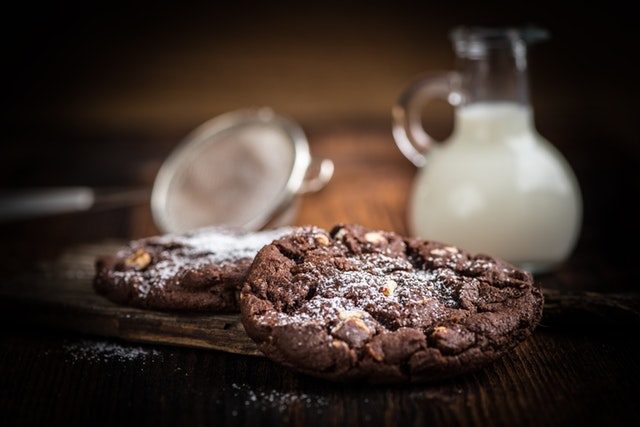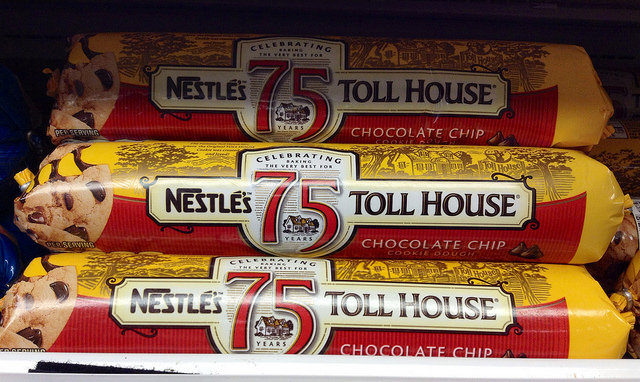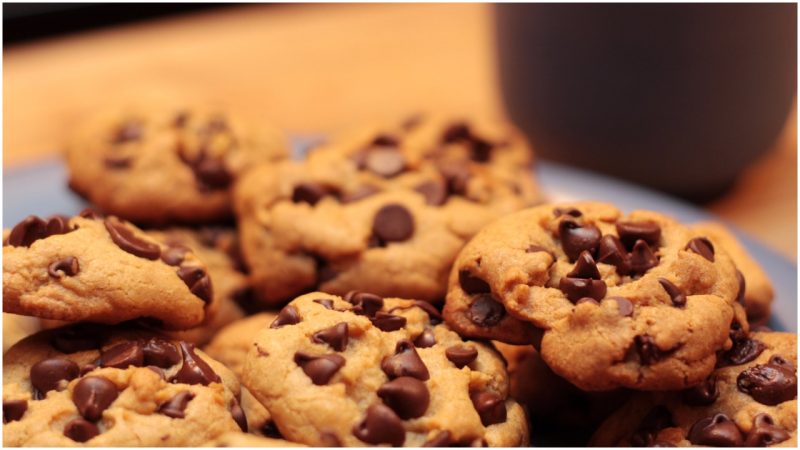How does this sound?
Preheat oven to 375º F. Mix 2 cups and 1/4 quarter of all-purpose flour with 1 teaspoon of salt and 1 teaspoon of baking soda in a small bowl. Beat 1 cup or 2 sticks of softened butter with 3/4 cup of brown sugar and 1 teaspoon of vanilla extract in a large mixer bowl, and stir until creamy. Right after, one at a time, add 2 large eggs and mix. Pour in the flour mixture gradually while still stirring, and finally add 2 cups of Nestle Toll House Semi-Sweet Chocolate Morsels and 1 cup of chopped nuts to the mixture.
Spread the whole mixture spoon by spoon onto a baking sheet, bake, and wait for about 10 minutes until golden. Pour yourself a glass of milk, or brew a cup of black tea, heap those aromatic, fresh baked, crispy-looking chocolate-chip cookies onto a platter, and prepare to taste heaven.

This is the original chocolate-chip-cookie recipe created by the owner of a popular restaurant in the town of Whitman, Massachusetts, who had sought to serve something different to her customers.
And indeed she did, to the delight of those customers and humanity as well, enriching lives from that day onward with a delightful sweet guilty pleasure.
In 1930, Kenneth and Ruth Graves Wakefield purchased a tourist lodge between Boston and New Bedford. The place had been used as a toll house in the 19th century, where people passing by would stop to switch horses and have a hot meal. The family took over the lodge and named it the Toll House Inn, where they would serve home-cooked meals.
Ruth, a graduate of Framingham State Normal School Department of Household Arts, considered herself an eternal student of human nutrition. She enjoyed experimenting with sweets to serve as desserts to customers after their meals were over, sending them back on the road entirely satisfied.
Soon enough she and her kitchen became famous for the lobster dinners and the desserts, especially her thin butterscotch-nut cookies that she liked to serve with ice cream. Everyone seemed to enjoy it, so she tried to give them something different, surprise them with a new taste when they would ask for the butterscotch cookie. After some trial and error, the Toll House cookie was born.
Meanwhile, year after year from 1930 onwards, she published a cookbook. In the ninth edition of the now best-selling Toll House Tried and True Recipes, Ruth decided to release the recipe for her chocolate chip cookie, naming it the “Toll House Chocolate Crunch Cookie.” It was 1938, and word about this sweetest of sweet delights had already spread locally, so the cookbook was sold out within days.
After World War II began, U.S. soldiers from Massachusetts sent overseas shared the cookies sent in care packages from their families back home with fellow soldiers from other states. Consequently, the supply of cookies ran out quickly and newly converted soldiers asked for more, urging their moms or spouses to search for this Toll House cookie recipe and bake them. With this, the nationwide craze for the chocolate chip cookie had begun.

And as the popularity of the cookie increased, so did the sales of Nestlé’s semi-sweet chocolate used in the making. Witnessing this, Andrew Nestlé offered Ruth a deal to buy the rights to her recipe, as well as the rights to use her and the Toll House name when advertising his acquisition.
Ruth accepted the business proposal for this amount: one whole dollar and a lifetime supply of Nestlé chocolate. The deal was struck.
Nestlé quickly launched a new marketing campaign that advertised the chocolate chips primarily as main ingredients for cookies, engraving the recipe for the Toll House Cookie on the package print.
Wakefield passed away in 1977, and her legendary Toll House Inn went up in flames after the kitchen, which was not being maintained properly, sparked a fire and burned the place to the ground on New Year’s Eve 1984. The site is still on maps, forever marked as the place where the Toll House once stood.
And Nestlé still prints the recipe on the back of each package of the Toll House Morsels.
